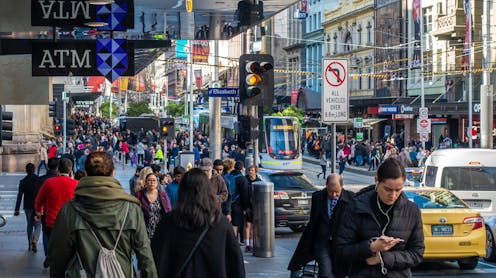Yes, government influences wages – but not just in the way you might think
- Written by David Peetz, Laurie Carmichael Distinguished Research Fellow at the Centre for Future Work, and Professor Emeritus, Griffith Business School, Griffith University

Can the government actually make a difference to the wages Australians earn?
A lot of attention always falls on the government’s submission to the Fair Work Commission’s annual wage review, which this year called for[1] a real boost to award wages, above the rate of inflation.
The commission’s decision has a big impact on wages received by at least a quarter of employees, many among the lowest paid. While the government’s submission must make some difference to the outcome, it’s hard to quantify how much of a difference that is.
My new research[2] for the Australia Institute’s Centre for Future Work focuses on another, possibly bigger impact the government can have on wages – certainly one that affects a wider range of workers. This is its effect on the bargaining power of all workers and employers.
We had a long period of poor wages growth, against a backdrop of low power for workers, driven both by markets and policy. More recently, though, the tide has started to turn.
Read more: Labor wants to give the minimum wage a real boost. The benefits would likely outweigh any downsides[3]
The economy and worker power
In recent decades, trends in the economy and labour market almost all worked to reduce worker power. My research examined 16 economic or related factors that were considered to either influence or indicate power in the labour market.
Almost all have reduced workers’ power over the medium to long term. One had ambiguous effects. Only one had the opposite effect and helped boost worker power for a while.
Among the many factors reinforcing or reflecting less bargaining power for workers were:
- long-term declines in union membership, collective bargaining coverage and industrial action
- the expansion of the “gig economy”
- the growth of casual employment, particularly between the 1980s and 2000s
- a reduction in job switching among employees
- growing use of outsourcing and contracting out, to do work formerly undertaken within large organisations
A decline in the gender pay gap suggested a gradual increase in female workers’ power, relative to equivalent male workers at least.
The only factor that could increase overall worker power was the decline in unemployment from 2010 to 2023 (setting aside the pandemic blip).
Policies limiting workers’ power
With the Coalition in government from 2014 to 2022, a lot of policy acted to reinforce the loss of worker power that had happened due to economic and labour market trends.
Of the seven major federal policy changes considered in this period, five acted to reduce workers’ power (including the establishment of new bodies regulating unions and the abolition of a transport safety regulator).
Only two increased it (including some tighter regulation of franchises).
A change of course
After Labor came to power in 2022, a series of (mostly legislative) changes were introduced. Out of 23 federal policies implemented by the government, 22 increased workers’ power.
These included policies to:
- abolish new bodies regulating unions
- limit the use of fixed-term contracts
- expand workers’ rights to request flexibility
- make it harder for firms to classify workers as contractors
- create protections for “employee-like” workers
- expand the scope for multi-employer bargaining.
Only one reduced worker power – clarifying certain exemptions for small business – and its impact was neither large nor controversial.
What’s been the outcome for wages?
So, what’s happened to Australian wages under these different policy environments?
Some policies, such as protections for “employee-like” workers, could not yet have a measurable impact. The most recent policy, banning non-compete clauses[6] for middle and lower-income workers, was only announced in March.
Still, three major measures of wages growth, that performed poorly from 2014 to 2022, showed some upturn from the end of 2022.
Overall, wages growth[7] mostly averaged a little over 2% per year through most of the period from 2014, falling then recovering in the pandemic.
It’s been 3%, 4%, or more since the end of 2022, against a backdrop of higher inflation.
Wage increases under new enterprise agreements[8] gradually declined from around 3.5% a year in 2014 to about 2.5% in 2022. However, they have grown since then and peaked at 4.8% at the end of last year.
The data suggest wage gains associated with increased worker power are experienced by both union members and non-members – but that union members benefit the most.
Inflation not the cause
There’s an argument that Australia’s recent growth in wages is simply a response to a temporary surge in inflation.
But we can look at how big a share wages make up of Australia’s total national income. From 2014 to 2022, we see the wages share of national income[9] falling, then rising sharply until today. If inflation was the only cause of the upturn, labour’s share would not have grown like this.
This increase occurred while inflation was falling — from over 7% at the end of 2022, to below 3% at the end of 2024. So, wages growth clearly hasn’t caused a rise in inflation.
The verdict: do governments really make a difference?
My research suggests the answer is yes, governments can influence wages. The direction of influence depends very much on who is in government, most importantly in the federal parliament.
One of the biggest ways governments have affected wages over the past decade has been by taking power away from workers — and then by giving some of it back.
Returning some of that power to workers has correlated with the fastest growth in wages for a decade, and a growing share of national income going to wages, despite falling inflation.
References
- ^ called for (theconversation.com)
- ^ research (futurework.org.au)
- ^ Labor wants to give the minimum wage a real boost. The benefits would likely outweigh any downsides (theconversation.com)
- ^ Dean Lewins/AAP (photos.aap.com.au)
- ^ Lukas Coch/AAP (photos.aap.com.au)
- ^ non-compete clauses (ministers.treasury.gov.au)
- ^ wages growth (www.abs.gov.au)
- ^ new enterprise agreements (www.dewr.gov.au)
- ^ wages share of national income (www.abs.gov.au)
Authors: David Peetz, Laurie Carmichael Distinguished Research Fellow at the Centre for Future Work, and Professor Emeritus, Griffith Business School, Griffith University







